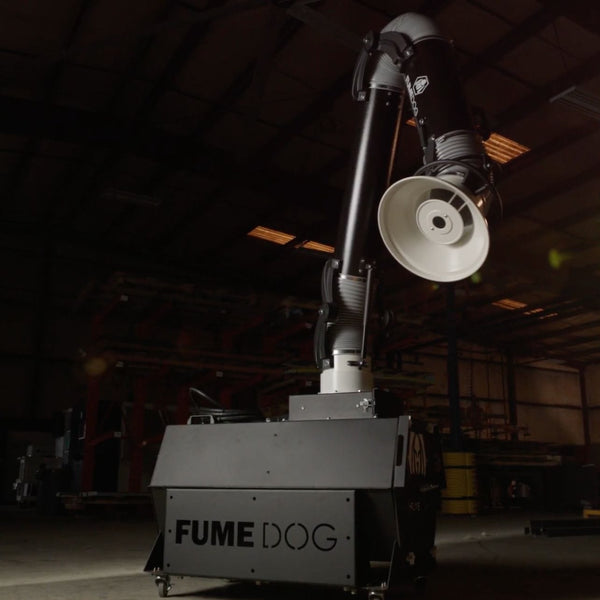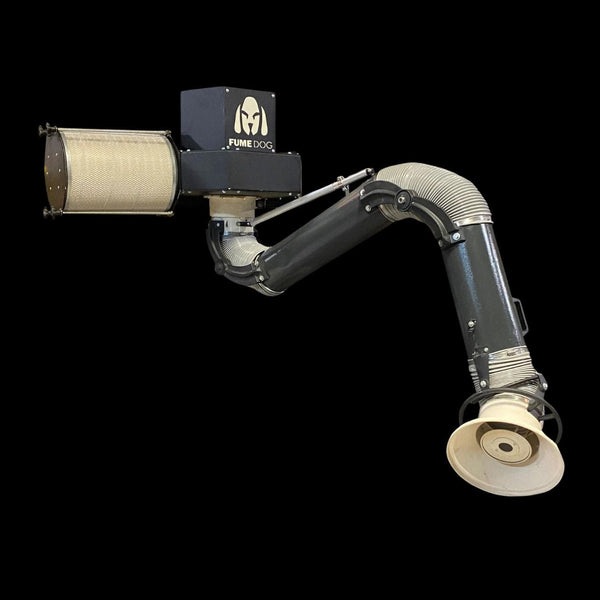
If you're in the welding industry, you recognize the inherent dangers that come with metal fabrication. Besides the abundant presence of sparks, flames, and heat, welding produces high amounts of toxins into the air that can cause long-lasting injuries and health complications.
Luckily, these dangerous fumes don't stop workers from welding, thanks to advanced extraction devices that continuously clean available air. To better protect yourself, employees, or welding students, it's crucial that you understand how toxins are removed and the air is recycled. For your convenience, here is an in-depth look at how fume extraction systems work.
What Is Fume Extraction?
In short, fume extraction is the removal of toxins from the air during the welding process. More technically speaking, extractors utilize negative draft that pulls in fumes, dust, and other particles away from workers.
These toxins are fed through advanced gravity filters that capture any impurities, leaving behind safe air. Fume extraction systems are placed near workstations, adjacent to the metal being worked on by employees or students. This allows for continual cleaning without creating additional obstacles for individuals to work around.
There are also natural ways to extract fumes that operate the same way as machines, but heavy-duty equipment is required for more extensive workshops. Combining a few extraction methods effectively protects everyone working with metal or anyone around welded objects.
Why Is Fume Extraction Important?
There's no denying that welding is among the more dangerous professions around today, and there are plenty of factors that threaten the well-being of working individuals. As stated earlier, flames, sparks, and intense heat are present hazards, including falling objects and severe cuts. Toxic fumes, unlike other obstacles, have the potential to wreak havoc on a person's internal well-being. Here are some metals that, when welded, produce harmful gases and particles:
Aluminum, Antimony, Arsenic, Beryllium, Cadmium, Chromium, Cobalt, Copper, Iron, Lead, Manganese, Nickle, Silver, Tin, Titanium, Vanadium, Zinc
There are also plenty of gases produced by metal fabrication that are important to look out for:
Argon, Helium, Nitrogen, Carbon Dioxide, Nitric Oxide, Nitrogen Dioxide, Carbon Monoxide, Ozone, Phosgene, Hydrogen Fluoride
From the outside looking in, it seems like welders are threatened by the entire periodic table on a daily basis. While not totally false, the dangers of these metals and fumes are not nearly as pressing in today's industry, thanks to better education and stringent workers protection laws. OSHA, the Occupational Safety and Health Administration, sets strict guidelines for all commercial welding workshops so that workers can live many years post-retirement without nagging health concerns. Advanced fume extraction systems are a must to meet these occupational safety demands in any busy workshop.
Different Fume Extraction Systems
Not all fume extraction systems are the same, but they all function in a similar manner. Different source capture options allow for a more flexible work environment, and each specific system is designed to work most efficiently in relation to its setting. Below we explore the different fume extraction systems.
Natural Extraction
For weekend welders working in a small workspace, the need for a fume extractor machine isn't that pressing or even necessary. If you're welding alone, you can get away with natural extraction. For instance, openness in a work environment, like constant air circulation through windows and doors, accomplishes an extractor machine's job without the need for power or space.
If your workshop is located in a garage, you can simply open the garage door to allow superior airflow. Wearing PPE is a must, but the need for heavy machinery is less critical. Larger spaces like welding schools or warehouses sometimes combine machines and natural factors to better clean available air.
Portable
A portable fume extractor is one that isn't limited to one area and instead can be moved throughout a space freely. Using negative draft and fans, fumes are removed from the air and processed through the device's body.
These devices are moderately sized but still offer welders protection. Their flexible arms allow for precise placement, and the system as a whole has wheels for better transportation.
Wall-Mounted
"Wall-mounted" doesn't mean this extractor machine is any less flexible when compared to a portable one. In fact, wall-mounted fume extractors are more conducive for a small space, as the system hangs on the wall and away from foot traffic.
Like a portable device, an extractor arm is placed near a workspace as it continually recycles air. In short, a wall-mounted fume extractor allows for precise extraction without posing as another obstacle for welders. This setup is better for welding schools or large operations with many workspaces.
Downdraft Tables
Downdraft tables are perhaps the coolest forms of extraction machinery. Unlike the other devices listed above, these systems are dedicated worktables with built-in extraction technology. The primary device is positioned under the tabletop and pulls toxins down from the welded object.
Some models have an overhead extractor, and these systems work just as efficiently. The main appeal here is the lack of an extractor arm, giving a welder or welding student more space. Plus, they're pretty portable and great for a more fluid environment.
What Are the Needs of Your Workshop?
So, what does your workshop need when it comes to an efficient extraction system? Most simply put, whatever keeps dangerous exposure to a minimum, dictated by OSHA's regulations, is enough for your business. For welders who fabricate metal as a weekend hobby, the need for an advanced, heavy-duty system is not necessary, provided your space possesses optimal airflow. With a medium-sized workshop, a portable device is perfect, as it offers flexibility without sacrificing production.
A downdraft table works in nearly any environment, as it's not excessively large but accomplishes its jobs very effectively. As your operation grows in size, wall-mounted systems provide excellent extraction capabilities and maintain a hazard-free floor. Ultimately, the best extraction system for your workshop is up to your size, both in individuals, workstations, and overall space.
An in-depth look at how fume extraction systems work is only the first step towards ensuring the best possible working environment for yourself, students, and professional welders. Find the best equipment for your needs, and remember to prioritize safety over every other business aspect. FumeDog proudly carries a variety of devices fit for any workshop.






